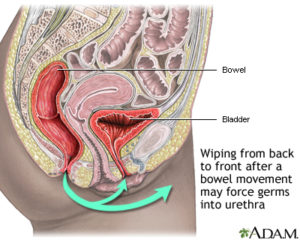Urinary tract infection – adults |
||
DefinitionA urinary tract infection, or UTI, is an infection of the urinary tract. The infection can occur at different points in the urinary tract, including:
Alternative NamesBladder infection – adults; UTI – adults; Cystitis – bacterial – adults; Pyelonephritis – adults; Kidney infection – adults CausesMost UTIs are caused by bacteria that enter the urethra and then the bladder. The infection most commonly develops in the bladder, but can spread to the kidneys. Most of the time, your body can get rid of these bacteria. However, certain conditions increase the risk of having UTIs. Women tend to get them more often because their urethra is shorter and closer to the anus than in men. Because of this, women are more likely to get an infection after sexual activity or when using a diaphragm for birth control. Menopause also increases the risk of a UTI. The following also increase your chances of developing a UTI:
SymptomsThe symptoms of a bladder infection include:
If the infection spreads to your kidneys, symptoms may include:
Exams and TestsMost of the time you will need to provide a urine sample for the following tests:
Blood tests such as complete blood count (CBC) and a blood culture may be done as well. You may also need the following tests to help rule out other problems in your urinary system:
TreatmentYour health care provider must first decide if the infection is just in the bladder, or if it has spread to the kidneys and how severe it is. MILD BLADDER AND KIDNEY INFECTIONS
RECURRENT BLADDER INFECTIONS Some women have repeated bladder infections. Your provider may suggest that you:
MORE SEVERE KIDNEY INFECTIONS You may need to go into the hospital if you are very sick and cannot take medicines by mouth or drink enough fluids. You may also be admitted to the hospital if you:
At the hospital, you will receive fluids and antibiotics through a vein. Some people have UTIs that do not go away with treatment or keep coming back. These are called chronic UTIs. If you have a chronic UTI, you may need stronger antibiotics or to take medicine for a longer time. You may need surgery if the infection is caused by a problem with the structure of the urinary tract. Outlook (Prognosis)Most UTIs can be cured. Bladder infection symptoms most often go away within 24 to 48 hours after treatment begins. If you have a kidney infection, it may take 1 week or longer for symptoms to go away. Possible ComplicationsComplications may include:
When to Contact a Medical ProfessionalContact your provider if you have symptoms of a UTI. Call right away if you have signs of a possible kidney infection, such as:
Also call if UTI symptoms come back shortly after you have been treated with antibiotics. PreventionDiet and lifestyle changes may help prevent some UTIs. After menopause, a woman may use estrogen cream around the vagina to reduce infections. ReferencesGupta K, Hooton TM, Naber KG, et al. International clinical practice guidelines for the treatment of acute uncomplicated cystitis and pyelonephritis in women: A 2010 update by the Infectious Diseases Society of America and the European Society for Microbiology and Infectious Diseases. Clin Infect Dis. 2011;52(5):e103-e120. PMID: 21292654 www.ncbi.nlm.nih.gov/pubmed/21292654. Hooton TM, Bradley SF, Cardenas DD, et al. Diagnosis, prevention, and treatment of catheter-associated urinary tract infection in adults: 2009 International Clinical Practice Guidelines from the Infectious Diseases Society of America. Clin Infect Dis. 2010;50(5):625-663. PMID: 20175247 www.ncbi.nlm.nih.gov/pubmed/20175247. Hooton TM. Nosocomial urinary tract infections. In: Bennett JE, Dolin R, Blaser MJ, eds. Mandell, Douglas, and Bennett’s Principles and Practice of Infectious Diseases. 8th ed. Philadelphia, PA: Elsevier Saunders; 2015:chap 304. Sobel JD, Kaye D. Urinary tract infections. In: Bennett JE, Dolin R, Blaser MJ, eds. Mandell, Douglas, and Bennett’s Principles and Practice of Infectious Diseases. 8th ed. Philadelphia, PA: Elsevier Saunders; 2015:chap 74. |


